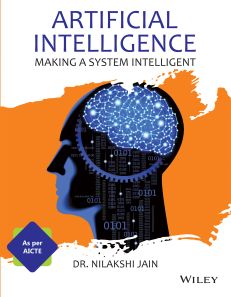Artificial Intelligence, As per AICTE: Making a System Intelligent
ISBN: 9788126579945
444 pages
Publication Year: 2019
eBook also available for institutional users
For more information write to us at: acadmktg@wiley.com

Description
Artificial Intelligence: Making a System Intelligent explains concept of intelligent systems, techniques from knowledge-based systems, neural networks, fuzzy systems, evolutionary computation, and intelligent agents. The principles behind these techniques have been explained in this book without resorting to complex mathematics. The lack of assumed prior knowledge makes this book ideal for any introductory course in artificial intelligence or intelligent systems design. The contemporary coverage of this book is highly beneficial to advanced students as it facilitates in discovering state-of-the-art techniques, particularly in intelligent agents and knowledge discovery.
1 Introduction to Artificial Intelligence
1.1 Introduction
1.2 Definition of AI
1.3 Goals of AI
1.4 Abridged History and Foundation of AI
1.5 Branches or Subareas of AI
1.6 Applications of AI
1.7 Categorization of AI
1.8 Components of AI
1.9 Current Trends in AI
1.10 AI Programming Languages
2 Intelligent Agents
2.1 Introduction
2.2 Intelligent Systems
2.3 The Concept of Rationality
2.4 Types of Agents
2.5 Environments and Its Properties
2.6 PEAS Representation for an Agent
2.7 Intelligent Agent Application
3 Problem Solving
3.1 Introduction to Problem Solving
3.2 Problem Formulation
3.3 State–Space Representation
3.4 Problem Formulation of the Eight Tile Puzzle
3.5 Problem Formulation of Water Jug Problem
3.6 Problem Formulation Vacuum Cleaner World Problem
3.7 Problem Formulation of Wumpus World Problem
3.8 Problem Formulation of Missionaries and Carnivals Problem
3.9 Production System
3.10 Difference between Conventional Problems and AI Problems
3.11 Searching
3.12 Problem Characteristics and Issues in the Design of Search Programs
3.13 Solving Problems by Searching
3.14 Types of Search Strategies
4 Uninformed Search Strategies
4.1 Introduction
4.2 Brute Force or Blind Search
4.3 Breadth-First Search
4.4 Depth-First Search
4.5 Difference between BFS and DFS
4.6 Uniform Cost Search
4.7 Depth-Limited Search
4.8 Iterative Deeping DFS
4.9 Bidirectional Search
4.10 Comparing Uniform Search Strategies
5 Informed Search
5.1 Introduction
5.2 Hill Climbing
5.3 Best-First Search (Greedy Search)
5.4 A* Search
5.5 AO* Search: (AND–OR) Graph
5.6 Memory Bounded Heuristic Search
5.7 Simulated Annealing Search
5.8 Local Beam Search
5.9 Branch and Bound Search
6 Adversarial Search
6.1 Introduction
6.2 Optimal Strategies
6.3 The Minimax Algorithm
6.4 Alpha–Beta Pruning
7 Constraint Satisfaction Problem
7.1 Introduction
7.2 General Form of the CSP
7.3 Map Colouring Problem
7.4 N-Queens Problem
7.5 N-Queens Problem Formulation
7.6 Forward Checking
7.7 Crypto Arithmetic Problem
8 Knowledge and Reasoning
8.1 A Knowledge-Based Agent
8.2 The Wumpus World
8.3 Knowledge Representation Issues
9 Predicate Logic
9.1 Representation of Simple Fact in Logic
9.2 Representing Instance and Is_A Relationship in Predicate Logic
9.3 Computable Functions and Predicate Logic
9.4 Resolution
9.5 Knowledge Engineering in First-Order Logic
9.6 Unification
9.7 Natural Deduction
10 Representation Knowledge Using Rules
10.1 Propositional Logic
10.2 Frist-Order Logic/Predicate Logic
10.3 Inference in First-Order Logic
10.4 Procedural versus Declarative Knowledge
10.5 Logic Programming
10.6 Forward and Backward Reasoning
10.7 Matching
10.8 Control Knowledge
10.9 Forward and Backward Chaining (Type of Reasoning)
11 Planning and Learning
11.1 Introduction
11.2 The Language of Planning Problems
11.3 Planning with State Space Search
11.4 Partial Ordered Planning
11.5 Hierarchical Planning
11.6 Conditional Planning
11.7 Learning Introduction
11.8 Forms of Learning
11.9 Inductive Learning
11.10 Learning Decision Trees
11.11 Ensemble Learning
11.12 Reinforcement Learning
12 Uncertain Knowledge and Reasoning
12.1 Uncertainty
12.2 Basic Probability Theorem
12.3 Joint Probability
12.4 Baye’s Theorem
12.5 Representing Knowledge in an Uncertain Domain (Bayesian Belief Network)
12.6 Simple Inference in Belief Network
12.7 Temporal Model
12.8 Markov Decision Process
13 Natural Language Processing
13.1 Introduction
13.2 Exponential
13.3 Natural Language for Communication
13.4 Syntactic Analysis
13.5 Argumented Grammar
13.6 Semantic Interpretation
14 Expert System
14.1 Expert System
14.2 Need and Justification of ES
14.3 Knowledge Representation
14.4 Knowledge Acquisition and Variation
14.5 Utilisation and Functionality
14.6 Basics of Prolog
15 Application
15.1 Introduction
15.2 Category of Applications of AI
15.3 Robotics
15.4 Artificial Neural Network
15.5 AI Trends in Various Sectors
15.6 More About Agents of AI
16 Cognitive Computing
16.1 Introduction
16.2 Foundation of Cognitive Computing
16.3 List of Design Principles for Cognitive Systems
16.4 Natural Language Processing in Support of a Cognitive System
17 Introduction to Soft Computing and Fuzzy Logic
17.1 Introduction
17.2 Soft Computing versus Hard Computing
17.3 Various Types of Soft and Hard Computing Techniques
17.4 Fuzzy Logic
17.5 Fuzzy Set versus Crisp Set
17.6 Membership Function
17.7 Fuzzy Rules
17.8 Fuzzy Reasoning
17.9 Fuzzy Inference System
17.10 Fuzzification
17.11 Defuzzification
17.12 Fuzzy Controllers
18 Artificial Neural Network
18.1 Introduction to Artificial Neural Networks
18.2 Basic Models of Artificial Neural Networks
18.3 First Artificial Neurons: McCulloch–Pitts Model
18.4 Neural Network Architecture
18.5 Single-Layer Feedforward ANN
18.6 Multilayer Feedforward ANN
18.7 Activation Functions
18.8 Supervised Learning
18.9 Delta Learning Rule
18.10 Backpropagation Algorithm
18.11 Unsupervised Learning Algorithm
18.12 Self-Organising Maps
18.13 Hybrid Approach: Fuzzy Neural Systems
Summary
Review Questions
Short-Type Questions
Multiple-Choice Questions
Answers
Further Readings
Index

